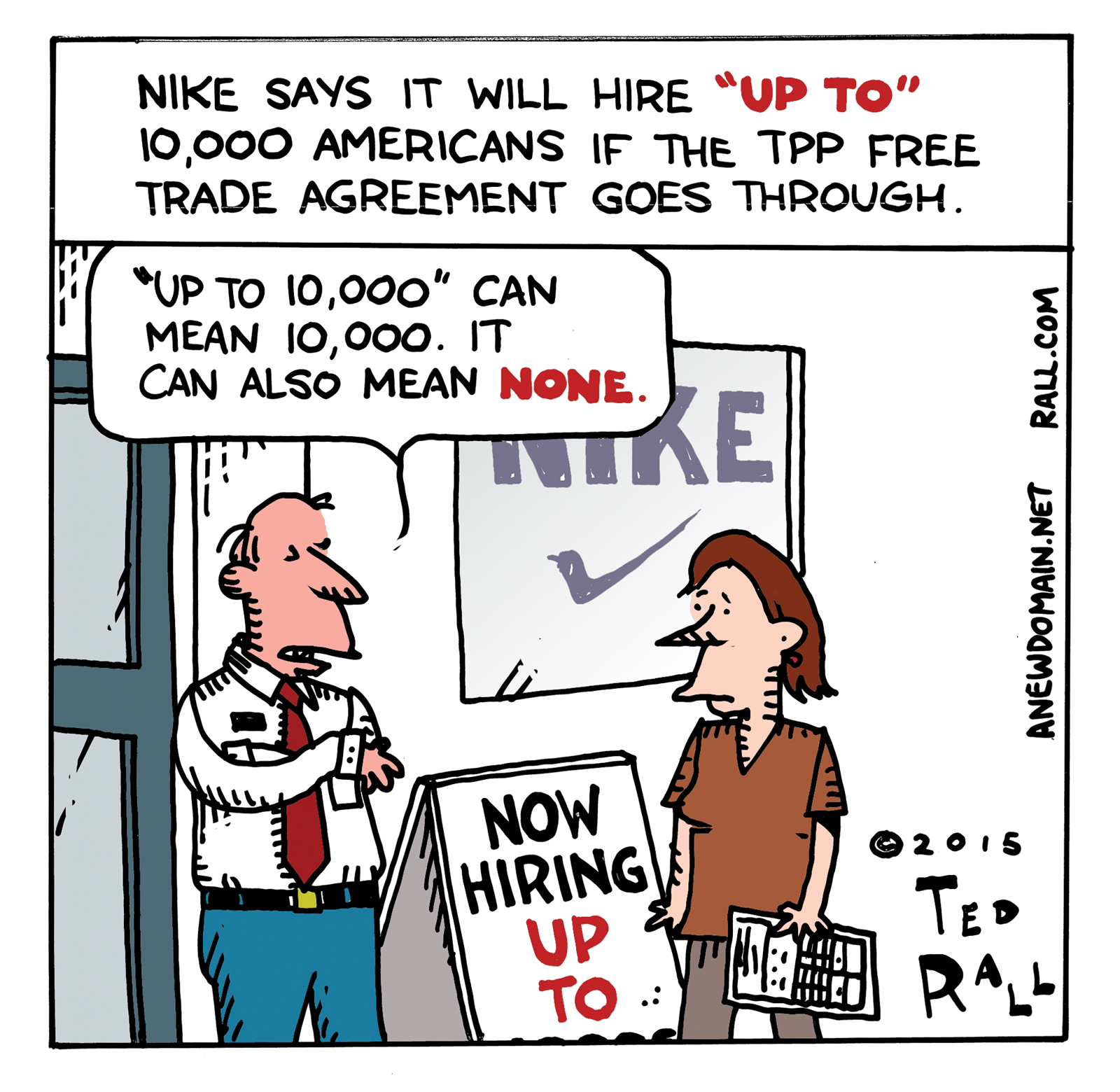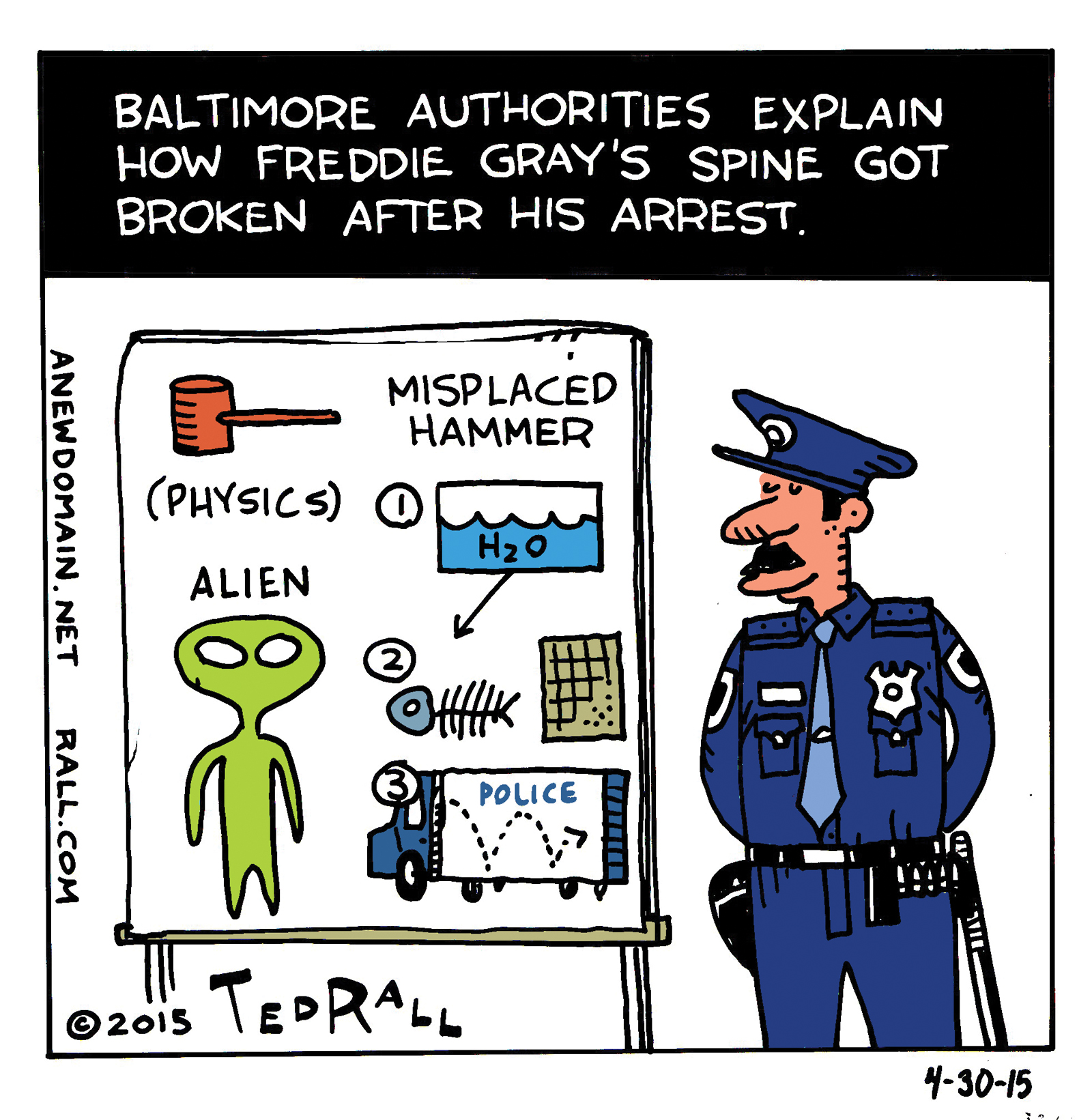Originally published by ANewDomain.net:
Nike promises to hire up to 10,000 people in the United States if the Trans-Pacific Partnership (TPP) free trade agreement passes.

Originally published by ANewDomain.net:
Nike promises to hire up to 10,000 people in the United States if the Trans-Pacific Partnership (TPP) free trade agreement passes.

Originally published by ANewDomain.net:
Americans are sympathetic to the plight of African immigrants drowning while trying to enter Europe, but they seem to care a whole lot less when the “illegal immigrants” are Mexican immigrants coming into the United States.

Originally published by ANewDomain.net:
Attempting to explain how Freddie Gray’s spine was broken in police custody, Baltimore police authorities release a report that implies that he may have suicidally attempted to beat himself to death in the paddy wagon. Uh-huh.

Originally published by ANewDomain.net:
Fellow political cartoonist Tom Tomorrow deploys a character, Officer Friendly. The always-smiling 1950s-style cop is a clever meme because it reminds us of what has been lost to the militarization of local policing: the fictions that their job is to keep us safe and that they work for us.
In case you harbor any lingering doubts about the true nature of the relationship between us ordinary serfs and the constabulary, the Guardian reports that the Missouri National Guard “used highly militarized language such as ‘enemy forces’ and ‘adversaries’ to refer to citizen demonstrators” in Ferguson during the protests following the shooting of Michael Brown, an unarmed African-American man:
Documents detailing the military mission divided the crowds that national guards would be likely to encounter into “friendly forces” and “enemy forces” – the latter apparently including “general protesters.”
A briefing for commanders included details of the troops’ intelligence capabilities so that they could “deny adversaries the ability to identify Missouri national guard vulnerabilities,” which the “adversaries” might exploit, “causing embarrassment or harm” to the military force, according to documents obtained in a Freedom of Information Act request by CNN.
And in an ominous-sounding operations security briefing, the national guard warned: “Adversaries are most likely to possess human intelligence (HUMINT), open source intelligence (OSINT), signals intelligence (SIGINT), technical intelligence (TECHINT), and counterintelligence capabilities.”
Isn’t that sweet.
Naturally National Guard officials are backtracking.
 Captain John Quinn says that ‘enemy forces’ really means “potential threats” like — as Dave Barry says, I am not making this up — “inclement weather, heat, failing levees, etc.”
Captain John Quinn says that ‘enemy forces’ really means “potential threats” like — as Dave Barry says, I am not making this up — “inclement weather, heat, failing levees, etc.”
Incoming. Failing levees?
“It’s disturbing when you have what amounts to American soldiers viewing American citizens somehow as the enemy,” said Antonio French, local alderman and captain of the obvious.
Except, it ain’t “somehow.”
In many American cities, particularly those with majority white police forces in minority neighborhoods, the police are an occupying army. They view the locals not as citizens whose taxes pay their salaries, who are in fact their bosses, but as dangerous, troublesome rabble to be contained, controlled and suppressed. The militarization of domestic policing, which dates back to the 1950s and the establishment of the first SWAT team in Los Angeles, further separates gendarmes from civilians via training derived from warfare, heavy body armor and wildly excessive firearms.
Trust in the cops is at a record low, thanks in part to ubiquitous cell phone and security camera videos that document police abuse so meticulously that it’s no longer possible even for white law-and-order types to deny accusations by blacks that the cops are treating them like dirt. Look for the cop-citizen gap to widen further as the police increasingly treat whites — for example, during the crackdown against the Occupy movement — badly as well.
The cops have met their enemy, and he is us.
And now there’s no denying it.
Originally published by ANewDomain.net:
A report by the Open Society Justice Initiative studied Obama’s drone strikes in Yemen and found that, contrary to assurances that drone strikes are only used when there is no other way to apprehend targets, people were killed even when the local authorities were ready, willing and able to arrest them. But arrests just aren’t as damned cool as drones.

Originally published at ANewDomain.net:
If you were impressed by how fast the FBI placed the blame for the Sony entertainment hacks on North Korea, you weren’t alone. Internet forensics are notoriously complicated, so this was obviously the result of amazingly efficient detective work, right?
Perhaps not.
A number of security experts doubt the US government’s claim of certainty in their accusation.
“The FBI says the attack came from IP addresses — unique computer addresses — that trace back to North Korea,” NPR reports. But those could be spoofed.
“The fact that data was relayed through IPs associated with North Korea is not a smoking gun,” Scott Petry, a network security analyst with Authentic8, told the network. “There are products today that will route traffic through IP addresses around the world.”
The FBI also points to malware used in the Sony attacks. Strings of that code, the feds say, are identical to those used in previous attacks known to have been carried out by North Korean hackers. Perry says that doesn’t mean anything either. Malware gets recycled by hackers all the time. “It’s like saying, ‘My God, this bank robbery was conducted using a Kalashnikov rifle — it must be the Russians who did it!'”
US government officials told the media that they found communications between the hackers that indicated their language of origin was Korean, and other experts say that conclusion is tentative and premature at best.
“Although it’s possible that these messages were written by people whose native language is Korean, it is far more likely that they were Russians,” said Shlomo Argamon, computer science professor at the Illinois Institute of Technology and chief scientist with Taia Global, after examining the writing style.
Finally, there’s the motive problem, as Wired puts it.
We’ve been told that the hacks were carried out on the order of a petulant dictator out to censor a film that disrespected his majesty, Seth Rogen and James Franco’s assassination comedy “The Interview.” But the demands of the hackers seem to align closer to a financial shakedown. Russians, then? In particular, the demands that Sony “pay proper monetary compensation” or face further attacks, points to someone other than a nation-state. Plus, for what it’s worth, North Korea has angrily denied involvement.
So if it wasn’t North Korea – or more accurately, if the US government isn’t 100% certain that it was North Korea – what are they saying that it was – or more accurately, that they are 100% certain that it was?
Robert Graham, CEO of Errata Security, speculated to Wired that a political hack within the FBI “wanted it to be North Korea so much that they just threw away caution.” Once the Obama administration repeatedly told the media that they knew it was North Korea, that became an official narrative that could never be walked back. “There’s this whole groupthink that happens, and once it becomes the message, it’s really hard to say no it’s not this.”
We have seen government groupthink before.
Within hours after the first plane hit the World Trade Center on September 11, 2001, network anchors and US government officials alike were openly jumping to the conclusion that Al Qaeda under the leadership of Osama bin Laden had to be responsible. As with the Sony hacks, what began as pure speculation based on circumstantial evidence – the theatrical nature of the attacks, their simultaneity and so on – soon became an official narrative that no one ever dared question, even when bin Laden denied responsibility (he had, on the other hand, claimed to have been behind the 1998 bombings of the US embassies in East Africa).
There are two parts of the equation here: responsibility and certainty. Who did it? How sure are we?
The FBI appears to be playing fast and loose with the latter question, much in the way that the Bush administration claimed to have been certain that the government of Iraqi dictator Saddam Hussein possessed weapons of mass destruction during the 2002-2003 run-up to the invasion of that country. The lie was not in claiming that Saddam possessed WMDs. The lie was claiming to be sure.
Bin Laden may well have been the sole financier and leader of the 9/11 plot, just as the North Korean government could be responsible for the Sony hacks. In both cases, however, a rush to judgment in anticipation of the facts may prevent some or all of the truth from ever coming to light. In the 9/11 case, for example, considerable evidence points to Islamic Jihad, a radical organization based in Egypt, as well as Saudi financiers. Pinning the blame exclusively on bin Laden and Al Qaeda let those guilty parties escape investigation, and perhaps punishment.
Similarly, the FBI’s premature passing of blame on the government of President Kim Jong-un could be muddying the waters, thus allowing the actual responsible parties to continue their activities and setting the stage for their next hack attack. Not to mention, is it really a good idea to antagonize a paranoid, nuclear-armed adversary that is already convinced the US intends to invade and occupy it, by falsely accusing them?
It would be nice, though perhaps too much to ask, for the United States government to seek the truth in a calm, deliberative manner. The media can wait after an attack to learn who’s to blame. So can we.
Originally published at ANewDomain.net:
It occurs to me, while following announcements of new gadgets coming out this week at CES 2015 in Las Vegas, that new technologies fall into different spectrums of desire. From a consumerism standpoint, new tech falls into four discrete categories (assuming one can afford them):
So lets look at some promising goods CES is full of this year, and see what spectrum of desire they fall under.
These are TVs with higher resolution than the standard 1,080-pixel wide model that’s probably in your living room right now. They’ve been around for a few years, but the price points (roughly $7,800 in 2012) have been way too high for the average American. Now that 4K televisions are being sold for under $1,000, and are actually approaching the $450 average price of a standard flat screen, we are being told that 4K is about to become the new standard.

That’s probably true. Streaming content providers like Netflix are teaming up with manufacturers to make it so, in the words of Star Trek’s Jean-Luc Picard, but I suspect that most Americans currently categorize the purchase of a 4K television somewhere between categories two and three, between “maybe” and “only if they make me.”
Mainly, this is because most human beings’ eyes can’t tell the difference between their current flat screen, which really looks damned good if you think about what television used to look like, and the newfangled ones. Inertia rules: why replace a perfectly good TV?
Well, because they’ll make us. For instance: bye-bye Betamax, hello VHS.
Nevertheless, 4K purchases will increase in the next couple of years as the old flat screens are discontinued and dismissed by appliance store salesman as obsolete, not because of pressing demand by viewers for higher resolution, but because the industry is moving that way. You’ll love it soon, I bet.
This year’s CES is showcasing the early stages of driverless cars in the form of vehicles that park themselves and then come back to you all by their lonesome. This happens as though delivered by an invisible valet with apps that unlock the door, start the engine and adjust the internal temperatures so that everything is just perfect before you get inside.
Hmm.
Polls show that Americans don’t really know how to feel about driverless transportation technology. They think they’re cool, but also disquieting. Some understand the efficiency and safety advantages, such as the fact that a highway could hold two or three times as many cars at rush hour while traveling at higher rates of speed, and that a computer can react more quickly than a human being distracted by a text message.

For geeks, driverless technology clearly fits into category one, a must-have. For the rest of us, there will probably be buy-in — but not before a lot of education. Driverless cars don’t mark the rise of Skynet, but there’s still a creep factor in surrendering control of the road to a device you barely understand. (If you don’t believe me, take the AirTrain into JFK airport. No conductor. I’m not a fan.)
And don’t get me started on the possibility that hackers could tap into your auto’s controls and drive you off a cliff.
I’m 95 percent sure driverless cars will become a thing. But there’s going to be a long psychological adjustment period.
Energy Management appliances and devices that use sensors, algorithms and predictive technology to save energy on your refrigerators and home cooling and heating, on the other hand, will likely enjoy intrinsic, immediate appeal to many, if not most consumers. Who doesn’t like to pay less?
Until now the sales of devices like the high-tech thermostat Nest have been constrained by their relatively high cost. As prices become more affordable and accessible, they will become standard in many homes.
Robotics, wearables and virtual reality products, on the other hand, will divide consumers into each of my four categories of consumerist desire: love, like, dislike and hate.
Google Glass and the Apple Watch anticipated for later this year are, depending on who you are, either the coolest or derpiest things ever. People either want to be seen everywhere with them or not caught dead near them. Some people even want to ban them. I believe that these will be divisive for the foreseeable future, until the marketplace and popular culture arrives at some sort of consensus over whether these are must-haves or must-avoids.
Me? I’m all in when it comes to 3D printing. How about you?
This essay was originally published at ANewDomain.net:
You never forget your first time.
I remember thinking: “God, this is without a doubt the best, most natural feeling condom I have ever tried, and I totally take back everything that I ever said about condoms making sex feel like you’re wearing a raincoat or whatever, and I’m going to take careful note of the brand of this condom so that I can buy thousands and thousands of them so that I can continue to enjoy this experience even if, by some terrible act of capitalism gone awry, the outfit that makes them goes out of business.”
Then I looked down and realized that the reason that that particular condom felt so great was that it had broken.
A meta-study conducted by the Kinsey Institute over the course of 16 years found that as many as 40 percent of sexually active Americans have experienced a condom break. Family planning experts believe that roughly 3 percent of condoms break.
Condoms are practically a religious necessity in the post HIV-AIDS era, particularly among Millennials and Generation Xers. But condoms aren’t foolproof. They leak. They break. Which is why 15 percent of people who use them still get pregnant.
You might get lucky. Since it has happened at least five or six times to me, maybe it will never happen to you. However, just you are an unlucky soul like me, it’s much smarter to be prepared for the possibility of a ruptured rubber than to trust in the fates.
Odds are, you probably won’t realize your prophylactic ripped until it’s too late – i.e., after you ejaculated. So if – okay, when – it happens, what should you do?
There are two concerns: STDs and pregnancy risk. What you choose to do about each depends on variables like how much you know about your partner, whether or not you are monogamous, and the point in your partner’s menstrual cycle.
Let’s start with the STD issue.
First thing: after sex, take a shower and thoroughly wash your genitals with soap and water. Believe it or not, this basic step could help you dodge a bullet. Do not douche.
Reach around and make sure you get all the little pieces of plastic. Sometimes it doesn’t break in one or two pieces. You don’t want to leave that stuff in your junk.
If you lose a condom during sex with a partner with whom you are both certain that you are monogamous, and you have both been recently tested for standard STDs including HIV-AIDS, you probably don’t have much to worry about.
If, on the other hand, it occurs with someone whose sexual history you aren’t certain about and/or hasn’t been tested extremely recently, get postexposure prophylaxis (PEP). PEP is a “morning after” treatment that can (but isn’t guaranteed) to prevent HIV infection. You take HIV antiretroviral meds for a full month. It’s definitely best to begin them immediately, but they can work up to 72 hours after possible exposure. Side effects include nausea and fatigue.
You can get it from any doctor, health clinic, AIDS organization, local health department, or hospital emergency room.
If you are a woman, you should more seriously consider a PEP treatment course than if you are a man due to the fact that HIV transmission is more likely from male to female than the other way around.
Morning-after pregnancy prevention, which used to be confusing and difficult to obtain in a timely manner, is now available over-the-counter in the United States. All women should keep the high dose birth control pill Plan B (cost $50 to $60 at most pharmacies), which is also known as emergency contraception, in their medicine cabinets so that it’s there in case of a condom accident. After the incident, take it as soon as you can, certainly under 24 hours later, but it can be effective if taken within 72 hours. Unfortunately, you have to be 17 years old or older in order to purchase Plan B without parental consent. You didn’t hear it from me, but if you don’t have understanding parents, this is a time to reach out to your older, cooler, over 17 friends.
If a condom breaks, there’s no need to freak out. For one thing, it probably won’t happen on one of the five days a month during which a woman can become pregnant. This is obviously a decision that you need to make for yourself, but if this happens to you outside of the so-called “fertile window,” the chance that you will suffer an unwanted pregnancy is slim to none, no matter what.
Most experts say you should both be tested for the usual standard battery of sexually transmitted diseases after something like this occurs, and that’s true, but the smarter, more relevant advice is to get tested regularly, especially if you and/or your partner are nonmonogamous.
Bottom line: Though obviously disturbing, a condom break is nothing to jump off a bridge over. They happen occasionally and the vast majority of the time – pretty much all of the time – no one gets an STD and no one gets pregnant as a result. Just make sure you reduce the chances of it happening over and over again, by using new condoms, not old ones, storing them in a cool place, investing in high-quality brands, and getting the right size.
Check out my new cartoon about how the NSA is bringing gun nuts together with civil libertarians at ANewDomain. Bear in mind, they pay real rates for original cartoons, so if you want to support cartooning and my work, please click over there, and if you like it, send other people there too. Thanks!